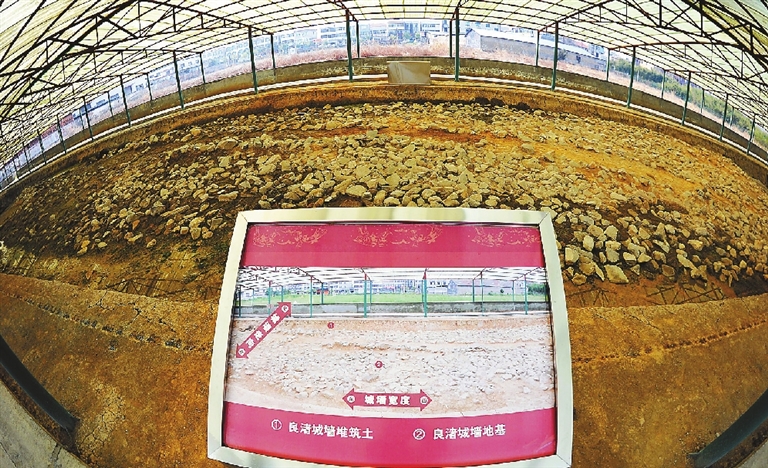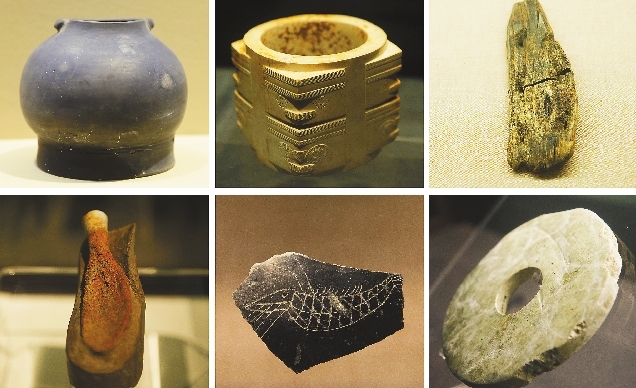

EVERY Chinese child is taught at school that the country’s civilization is 5,000 years old, but proving this beyond doubt has been a problem. Now, a jade artifact dubbed “King of Cong,” found in the Liangzhu city ruins near Hangzhou, Zhejiang Province, has provided an answer. According to radiocarbon dating, the 6.5-kilogram object, boasting exquisite decorative patterns and sacred emblems, is 5,300 years old. It is clear how the item acquired its nickname. It is one of the largest and most complicated ornaments among all cong, a type of jade piece that forms a tube with a circular inner section and a square outer section, from Liangzhu. The piece has now won greater global recognition, as the Archaeological Ruins of Liangzhu City were inscribed on the UNESCO World Heritage List on Saturday during the 43rd session of the World Heritage Committee in Baku, Azerbaijan. It is the 55th Chinese entry on the list. However, the site features far more than just jade items. The core area, spread over 14.3 square kilometers in Hangzhou’s Yuhang District, includes not only a city’s ruins but 11 dams and several cemeteries, all about 5,000 years old. Archaeological evidence shows that Liangzhu was inhabited for about 1,000 years. “The archaeological ruins of Liangzhu (3300 to 2300 B.C.) reveal an early regional state with a unified belief system based on rice cultivation in Late Neolithic China,” the UNESCO World Heritage Committee said. “These ruins are an example of early urban civilization expressed in earthen monuments, urban planning, a water conservation system and a social hierarchy seen in differentiated burials in cemeteries within the property.” According to studies led by Liu Bin, director of the Zhejiang Provincial Institute of Cultural Relics and Archaeology, the inner section of the ancient city ruins covers 2.8 sq km, about five times the area of the Forbidden City in Beijing, and the outer city spreads across 6.3 sq km. Liu said it was the biggest city ruins site of its time frame to be found in China, and was also one of the largest cities of its day in the world. Its Mesopotamian counterpart, Uruk, key Sumer city ruins in modern-day Iraq dating from 5,800 to 4,000 years ago, covers 810,000 square meters. Deity and kingship In 1936, during an archaeological investigation at Liangzhu, in Yuhang, more than 10 Neolithic sites were excavated, resulting in the discovery of black pottery. Some similar sites were found in the 1950s in nearby Jiangsu Province and Shanghai around Taihu Lake, with archaeologists creating the term “Liangzhu Culture” to describe them. Despite discoveries elsewhere, no high-level burial objects such as jade items had been unearthed in Zhejiang for a long time. During construction of a factory on a site at Fanshan in 1986, a suspected archaeological ruin was reported underground. Liu went there to put the discovery to the test. “I never expected to uncover such a tremendous hoard of jade,” he said. “King of Cong” was unearthed there. In Fanshan cemetery, 11 tombs were found containing 1,200 artifacts, 90 percent of them jade. In 1987, another 12 tombs were found on a site at Yaoshan, thought to be the ruins of an altar, where more than 700 jade artifacts were excavated. “These findings launched a new era,” Liu said. “The emblem on the artifacts helped us greatly to know the cultural meaning of jade at that time.” The emblem, a human-shaped deity riding on an animal mask motif, is ubiquitous on jade items buried in the Liangzhu Culture tombs. Worship of this deity never ceased in its 1,000-year history. “Jade is an indicator of people’s social status, and not only used for decoration,” Liu said. “It portrays a realm with a combined authority of deity and kingship.” He thinks that “King of Cong” belonged to a top-level ruler, who was probably also a religious chief. In addition to cong, hollow discshaped artifacts called bi that represented women’s elegance, along with ax-shaped artifacts called yue, symbols of power, are also typical items from Liangzhu. They later proved to be key items from rituals in ancient China. New understandings In the West, the appearance of a city, written characters and metallurgy have been commonly considered as three basic elements to judge whether a culture had become a “civilization.” In Liangzhu Culture, some 600 drawings were found on black pottery, which were thought to be prototypical written characters, but no evidence of metallurgy, such as bronzeware, was found. However, Liu said those criteria cannot “fit all civilizations.” “Metallurgy was used as a benchmark because it indicated developed craftsmanship and a society with well-organized labor cooperation,” he said. “Jade also proves these points.” Studies of Liangzhu have led to Western scholars forming new views. British archaeologist Colin Renfrew, a fellow of the British Academy, said after his research in Liangzhu: “The importance of findings from the Neolithic Age in China has been greatly underestimated. Cong and bi unearthed from the Liangzhu historical site represent a unity of values in the region. The complexity of society in Liangzhu was on par with that of a country. This is the origin of Chinese civilization. “Viewed from a global perspective, Liangzhu has brought the origin of the state and society in China to a level equal to that of civilizations in Egypt, Mesopotamia and India. “The historical site at the Liangzhu dam might be the earliest one in the world,” Renfrew added. Scholars once considered that the Central China Plain along the Yellow River (the plain is commonly known as Zhongyuan) was the cradle of Chinese civilizations, and Liangzhu Culture was once downplayed by academia as being a branch of a counterpart spreading from the North. “However, Liangzhu Culture has its unique character and proves that the Yangtze River is another cultural hub,” said Song Xinchao, deputy director of the National Cultural Heritage Administration. He added that what is now known about Liangzhu is only the “tip of the iceberg.” “Liangzhu Culture needs much follow-up work to figure out the social changes,” he said. “We’re glad a framework for comprehensive studies has been established.” “Archaeological studies of Pompeii in Italy began in 1748, and are still ongoing,” he said. “We need such a sense of lasting responsibility when studying Liangzhu as well,” he added. (China Daily) | 
